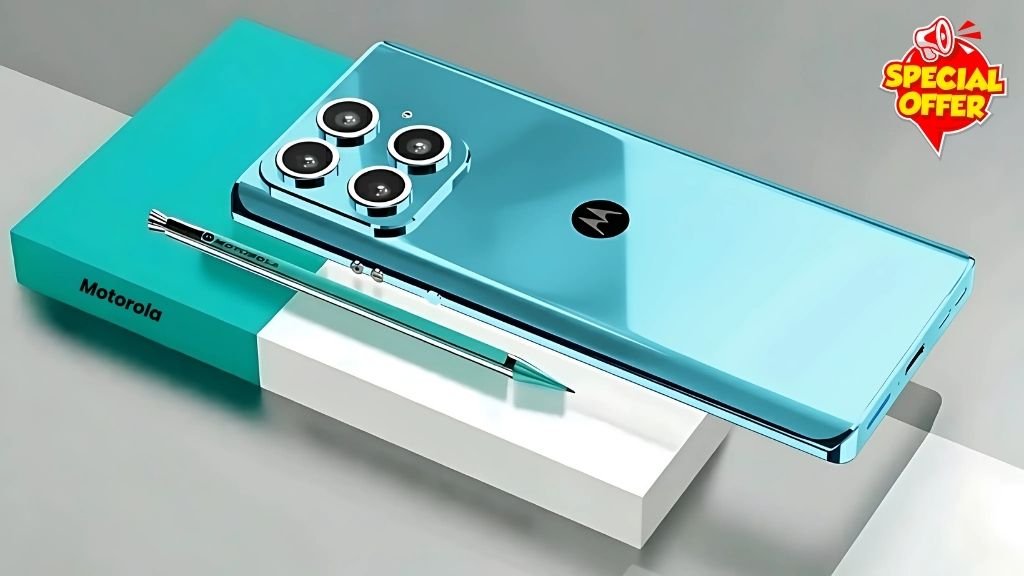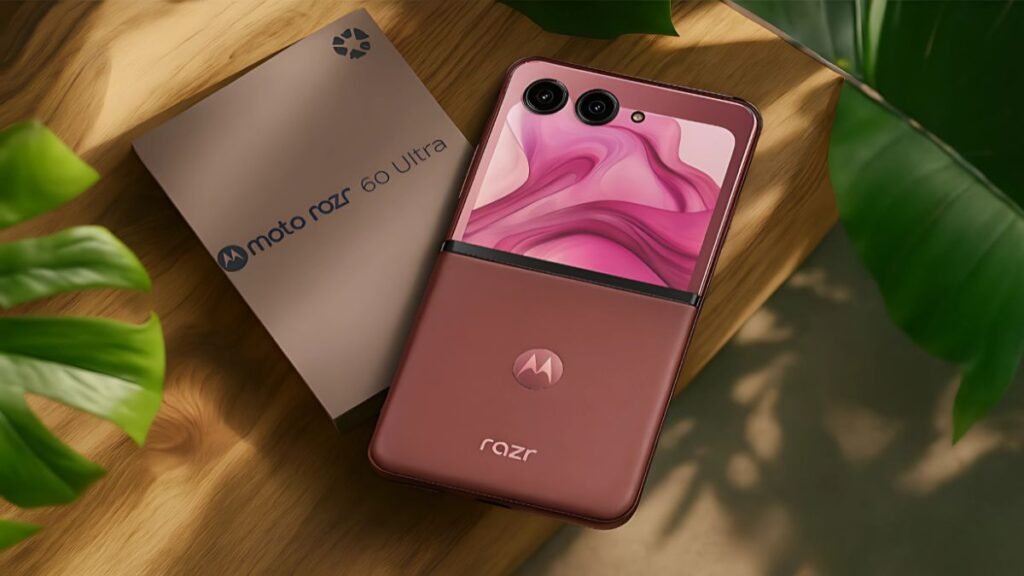Motorola Moto 50 Ultra 5G Launched: If you’ve been eyeing a no-nonsense Android flagship that mixes high style with high speed, the Motorola Moto 50 Ultra 5G (sold globally as the Motorola Edge 50 Ultra and in China as Moto X50 Ultra) is the headline act. It brings a 144 Hz pOLED display, a Snapdragon 8s Gen 3 platform, super-fast 125 W charging, and a genuinely versatile camera trio—while layering on tasteful design flourishes like Pantone-validated color science. In short: this is Moto’s “everything flagship” for people who want premium without pretense.
Launch at a Glance: Names, Markets, and What’s Actually New
Let’s clear the naming first so you don’t get lost in the alphabet soup. The device you’ll see referred to as Moto 50 Ultra 5G is the same platform Motorola sells globally as the Edge 50 Ultra and in China as the Moto X50 Ultra. The series debuted internationally in 2024 and rolled out across Europe, Latin America, Asia and Oceania, with North America excluded at launch. The pitch is simple: a flagship-grade display, cameras, and charging—on a lean, near-stock Android build—with “Moto AI” conveniences sprinkled in. Pricing at debut put the Edge 50 Ultra around the premium mark in Europe and the UK, positioning it below many halo phones while still feeling every bit premium in hand.
Design & Build: Leather, Metal, and the Right Kind of Luxury
Motorola’s recent design language balances comfort and confidence. The Moto 50 Ultra 5G leans into that with soft-touch vegan leather or matte finishes, tight panel gaps, and a compact-for-the-class footprint. Subtle curvature meets flat edges, so it nestles into your palm instead of digging in. The camera island is sculpted but not ostentatious; the materials feel flagship without being slippery. Motorola’s Pantone collaboration isn’t just marketing—skin tones and everyday scenes look more natural in camera previews and on the display, helping you trust what you shoot and what you see. Durability is solid as well, with sturdy glass and a reassuring frame that resists flex. Little touches—like excellent haptic tuning and meticulous port/speaker alignment—give the phone that “finished” feel many mid-range pretenders miss.
Display: A 144 Hz pOLED That’s Built for Scrolling, Shooting, and Streaming
On the front sits a 6.7-inch pOLED panel that supports 144 Hz for buttery UI motion and smooth gaming. Resolution lands in the 1.5K class with high pixel density for crisp text and confident color rendering. HDR video looks lively without cartoonish oversaturation, and peak brightness climbs high enough to stay readable in harsh midday light. What we appreciate most is how the display’s tuning complements Moto’s color pipeline—you get a look that’s punchy yet believable, whether you’re grading a TikTok clip or proofing a deck on the go. If you’re coming from a 60 Hz panel, the jump in fluidity is instant; even from 120 Hz, the extra polish is noticeable in fast feeds, maps, and long articles.
Performance: Snapdragon 8s Gen 3 Hits the Sweet Spot
Under the hood, Motorola picked Qualcomm’s Snapdragon 8s Gen 3 (3 nm)—a smart balance between the absolute bleeding edge and sustained, efficient speed. Paired with up to 16 GB RAM and 1 TB UFS 4.0 storage, the phone flips through heavy apps and keeps games pinned in memory without aggressive background kills. The 8s Gen 3 also unlocks slick camera tricks and on-device AI niceties without the heat spikes some bigger siblings suffer. In real life that means your music doesn’t stutter while you’re navigating and chatting—all at once. The win here is consistency: the phone feels the same at 9 a.m. as it does at 9 p.m., even after a long day of captures and edits. Motorola’s cooling stack helps sustain performance during longer gaming sessions or 4K video bouts.
Cameras: A 50-50-64 Trio That Earns Its Keep
Motorola’s flagship camera recipe reads: 50 MP main (large sensor, OIS), 50 MP ultra-wide with autofocus, and a 64 MP 3× telephoto with OIS. Add a 50 MP selfie and you’ve got symmetry front and back. The story isn’t just megapixels, though. The main sensor nails white balance and skin tones in mixed light; the ultra-wide’s autofocus makes it genuinely useful for close-ups; and the 3× lens gets you flattering portraits without leaning on digital zoom. Night shots keep detail in check without lifting shadows into mush, and stabilization settles handheld video nicely. If you prefer straight-out-of-camera colors that don’t need “fixing,” this system is a friend. For creators, 4K across lenses and solid HDR keep clips social-ready; for parents and pet owners, the fast, sticky autofocus is a quiet superpower.
Battery & Charging: 125 W Wired, 50 W Wireless—Because Time Matters
Capacity sits at 4,500 mAh, but the headliners are 125 W TurboPower wired and 50 W wireless charging. Coffee-break top-ups are a daily reality: a quick plug while you lace up for the gym nets hours of screen-on time. Wireless is fast enough to feel convenient, not punitive, and reverse charging helps your earbuds limp to the finish line. Battery health tools keep fast charging smart, and Motorola’s adaptive policies don’t throttle your life just to win a lab test. If you’re mapping, streaming, and snapping all day, expect comfortable endurance with room to spare; light users can stretch into a second day.
Software & Updates: Clean Android with “Moto AI” Where It Counts
Out of the box you get Android 14 (with rapid tracks to 15 and beyond), dressed in Motorola’s light-touch UX. It feels fast because it stays out of the way: no duplicate app stores, minimal nags, and thoughtful gestures (hello, double-chop flashlight). “Moto AI” adds useful flourishes—generative theming, camera assists, and smarter search—without turning your phone into a science project. Pair that with Google’s own suite (Magic Editor, Magic Eraser, Photo Unblur via Photos) and you’ve got creative tools that don’t require a manual. Motorola’s Ultra tier also enjoys a strong cadence of security patches and OS upgrades.
Connectivity & Extras: Little Things That Make a Big Difference
This is a global 5G device with wide band coverage, plus Wi-Fi 7, Bluetooth 5.4, dual-SIM (with eSIM in many regions), and NFC that just…works. Stereo speakers get a Dolby polish, and haptics are tight enough to make typing feel confident. The under-display fingerprint reader is quick, and face unlock handles bright and dim rooms without drama. Water ingress protection is improved over older Motos, and the chassis feels built for the long haul. If you bounce between cafés, co-working spaces and trains, this is the kind of phone that quietly keeps up rather than constantly asking for a wall.
Pricing & Availability: Where It Lands and Why That Matters
At announcement, pricing placed the Moto/Edge 50 Ultra under most “Ultra” rivals, yet well above mid-range pretenders. That pricing reflects the display, camera stack, charging silicon, and premium finishes—not just the chip. Markets included Europe, parts of LATAM, Asia and Oceania. If you’re in India or Europe, watch for promos as retailers rotate colorways and storage SKUs. The headline: you can often nab a flagship-grade experience for less than the usual suspects if you shop at the right moment.
Edge 50 Ultra vs. Moto X50 Ultra: Same Soul, Different Passport
Short version: Moto X50 Ultra (China) ≈ Edge 50 Ultra (global). Same Snapdragon 8s Gen 3 heart, same display cadence, same camera trio, same fast-charge stats; packaging, band support, and software services differ. The Chinese model leans harder into local cloud/AI integrations and may carry different RAM/storage SKUs. If you’re reading “Moto 50 Ultra 5G,” odds are you’re seeing retailer shorthand for one of those two. For import buyers: check 5G band compatibility and warranty terms before you pounce—North American carriers, especially CDMA-legacy ones, can be picky with “global” devices.
Real-World Performance: What It’s Like to Live With
Specs fade after week one; habits remain. The Ultra earns its name by being predictable—the good kind. It wakes instantly, survives accidental slideshow-length bursts of photos, and holds a signal in places where weaker modems fold. The camera flips between lenses without jarring color shifts, and the gallery template tools help you ship content faster. The 144 Hz panel makes long reads lighter on the eyes, and the battery’s “sip not gulp” behavior means late-night ride-hails aren’t a gamble. For most people, the only time you think about the phone is when someone asks, “Hey, what phone is that?”
Photography Deep Dive: Color, Texture, and Telephoto Discipline
A flagship camera is as much about restraint as reach. Here, metering favors natural tones over neon; skin looks human even under gnarly LEDs. The ultra-wide doesn’t warp faces at arm’s length, and macro focus is actually usable. Tele at 3× is the secret weapon: cleaner edges, better background separation, and fewer AI artifacts compared to digital crop. Low-light portraits roll off highlights without the “plastic” sheen that plagues some rivals. Video stabilization walks a nice line—gimbal-ish but not floaty—and HDR avoids the crunchy halos you sometimes see online. If your camera roll is 70% people/30% places, this setup is tuned for you.





